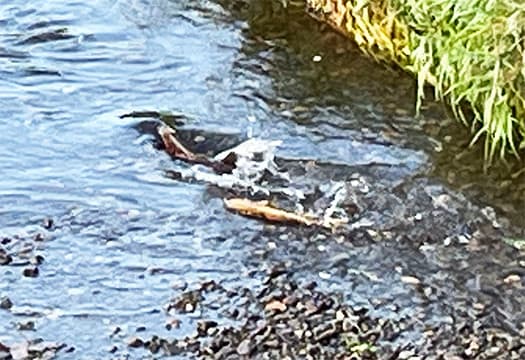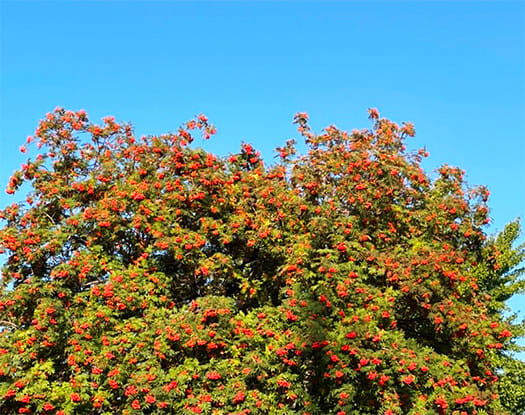

きのういつものように早朝散歩に午前6時頃に家を出たのですが、体感気温が予想以上に低く感じた。あとで調べたら7度程度ということでしたが、体感的には5度を下回っているようなレベル感。はやく寒さから逃れたいと通常よりも「速歩」気味にして体温上昇を一生懸命にこころみていました。10分程度早足で歩いている内にようやく馴染んできていましたが、普通のジャンパーを着込んでいましたが、これから場合によっては薄手のダウンジャケットも選択肢かと。
ということで近隣の「発寒川」流域の公園を歩いていたら、橋の欄干に人が集まって川面を注視している。「お、」というところ。案の定、鮭たちが発寒川を遡上している様子を観察しているのです。北海道人としては、まことに季節を知らせてくれる季語のような「イベント」。発寒川は結構な傾斜のある流路なのでところどころにサケの遡上用に造作が施されているのですが、そこを力を込めて遡上するのに、やや体力を整えてからチャレンジするところに遭遇していた。
写真ではやや鮮明ではないでしょうが、どうもオスメスのペアのように思えた。種としてのいのちの定めにためらうことなく立ち向かうかれらの姿は神々しい。観衆としての人間たちは、自然に誰言うともなく「応援」するような心理になってくる。地元のスポーツ選手を無条件に応援するような心理に近い。
そういえば先週末の買い物ではサケの獲れたてのヤツが1匹990円で販売されていて、即購入。ひとり1本限定販売。謹んで捌かせていただいた。白子が腹部から生々しく取り出せた。カミさんは「ゲっ」とひとこと(笑)。わたしは淡々と立ち向かって、赤身の本体を捌き終わったあと、白子を丁寧に調理させていただいた。煮物料理の主役として扱って料理したのですが、カミさんも恐る恐るだったけれど食べたら「うん、いけるね」。どうしても「アニサキス」の心配があるので、多少しっかり目に加熱調理した。
残ったアタマ部分と骨の部分は「アラ汁」として楽しんでおりました。って、まだアラ汁は半分しか材料を使っていないのでもう一回食べられる。もちろん肉身は50-60切れくらいに分けて冷凍。990円でコスパ最高レベル。
遡上を応援したり、その食味を味わわせていただいたり、北海道の秋にとってサケはまことに主役。
一方、散歩道のナナカマドの色づきも日々深まっている。メッチャ硬くて食用に調理するには7回くらいカマドを使うというものですが、冬の間、野鳥たちの貴重な栄養補給源にもなってくれる。
万物生々流転、おだやかに進んで行く秋の風情であります。
English version⬇
Sapporo's salmon run up the Hassamu River, Nanakamado, and autumn colors deepen.
The cold progressed rapidly during my early morning walk. It may be time to put on your down jacket. The salmon, both in taste and in the show of their return to the Hakkasamu River, are a favorite of the people of Hokkaido. Nanakamado trees are also beautiful. Sapporo
I left home around 6 a.m. for an early morning walk as usual yesterday, but the temperature I felt felt was lower than expected. I later checked the temperature and found that it was about 7 degrees Celsius, but my physical sensation was as if it was below 5 degrees Celsius. I tried my best to walk faster than usual to get out of the cold and raise my body temperature. 10 minutes of walking at a fast pace and I was finally getting used to it, but I was wearing a normal jacket, but I thought a light down jacket might be an option.
So I was walking in a park along the Hassamu River, and I saw people gathered on the parapet of a bridge, staring at the surface of the river. I was about to say, “Oh! Sure enough, they were watching salmon moving up the Hassamu River. As a Hokkaido native, this “event” is truly a seasonal reminder of the season. The Hassamu River is a fairly sloping stream channel, so it is built for salmon runs in some places, but I was encountering a place where I had to be somewhat physically fit to challenge the salmon to make a strong run up there.
The photo will be somewhat unclear, but it appeared to be a male-female pair. It was divine to see them face their destiny of life as a species without hesitation. As spectators, we naturally began to “cheer” for them, without anyone telling us to. It is similar to the mentality of unconditionally cheering for local athletes.
Speaking of which, when I was shopping last weekend, freshly caught salmon were on sale for 990 yen per fish, and I immediately bought one. Limited to one per person. I was respectfully allowed to handle it. The milt was freshly removed from the abdomen. My wife said, “Geez” (laugh). I faced her without hesitation and carefully cooked the milt after I finished processing the lean body. I treated it as the main ingredient in a stewed dish, and although Kami was a little afraid of it, when she ate it, she said, “Yes, it's good. I cooked it more or less thoroughly because I was worried about “anisakis” (an aquatic organism).
The rest of the fish, including the head and bones, was enjoyed as “ara-jiru” (soup with ara). I mean, I have only used half of the ingredients for the “ara-jiru,” so I can eat it once more. Of course, the meat pieces were divided into about 50-60 slices and frozen. 990 yen is the best level of cosmos.
Salmon are a mainstay of Hokkaido's autumn season, whether cheering for their return or savoring their taste.
On the other hand, the coloring of the Japanese white ash along the path is deepening day by day. They are so hard that it takes about seven times to cook them, but they are also a valuable source of nourishment for wild birds during the winter.
The autumn season is a time when all things are moving gently and gently.

















